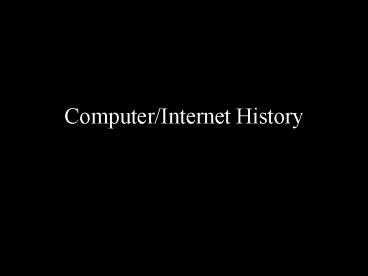ComputerInternet History PowerPoint PPT Presentation
1 / 31
Title: ComputerInternet History
1
Computer/Internet History
2
Analytical Engine 1837-gt, Charles Babbage (1792
-1871)A portion (completed 1910) of Charles
Babbage's Analytical Engine. Only partially built
at the time of Babbage's death in 1871, this
portion contains the mill (functionally
analogous to a modern computer's central
processing unit) and a printing mechanism.
3
Original design of the Analytical Engine 1840,
Charles Babbage (1792 -1871)
4
Lego Version of Charles Babbages Difference
Engine
5
George Boole 1815-1864 Boolean Algebra
Boole wanted to reduce human thought to to
mathematical operations. (Following a long line
of philosophers (and mystics) from the
Pythagoreans 500BC to Raymond Llull 1232-1315
and Gottfried Leibniz 1646-1716). Statements
can be either True or False (never both in the
same time). He introduced three operators
AND, OR, NOT that could be used on these
statements.
6
A Symbolic Analysis of Relay and Switching
Circuits Claude Shannon, 1937
Shannon was Vannevar Bushs student at MIT where
he worked on building a version of Babbages
Analytical engine. In A Symbolic Analysis of
Relay and Switching Circuits he describes how
Booles True/False statements could be translated
into an electronic circuit being either on or
off. This was a very important step towards the
digital computer.
7
A very simplified chart showing the concept of
layering in computers
Applications Photoshop, Word, Firefox
Code Formatting Languages - HTML, XML
Code Programming Languages
Code Assembly Language
Electrical Circuits with On/Off Switches
Computers work because we dont have to know how
they work.
On the other hand
To understand contemporary culture one has to
know at least one natural language and one
artificial. (Freidrish Kittler)
8
Memex (from As We May Think), Vannevar Bush 1945
9
ENIAC (Electronic Numerical Integrator and
Computer) 19468 feet (2.4 m) by 3 feet (0.9 m)
by 100 feet (30 m)
10
UNIVAC (Universal Automatic Computer) 1951The
first commercially available digital computer, 25
feet by 50 feet
11
Xanadu 1963 (ongoing), Theodore Nelson
Hypertext and Hypermedia
12
Douglas Engelbart (1925), Stanford Research
Institute
The first Mouse 1964?
Early Workstation with Keyboard and Mouse 1966
13
The Personal Computer
The first highly popular PC by IBM 1981 (Command
Line Interface)
Apple 1 1976 Sold without case, keyboard, and
monitor
DOWNLOAD VIDEO FROM WEB (See url on class website)
Macintosh 128K by Apple 1984 The first personal
computer with a Graphical User Interface
(developed simultaneously by Xerox PARC and
Apple)
Apples commercial for their new GUI computer.
14
1969 The beginning of the Internet ARPANET
(Advanced Research Projects Agency Network of the
United States Department of Defense)
RFC planning of first connection SRI to UCLA
UCSB the 3rd node (Located here in North Hall!)
Planning the ARPANET late 60ties
15
The World Wide Web
Conceived by Tim Berners-Lee at CERN
(Switzerland) in 1989. Inventing the World Wide
Web involved my growing realization that there
was a power in arranging ideas in an
unconstrained weblike way HTTP- HyperText
Transfer Protocol A specific way to send data on
the Internet HTML- HyperText Markup
Language Allowed for formatting text and images
and adding hyperlinks between pages.
Conceptually related to Xanadu and the Memex
First integrated text/image browsers Mosaic
1993, Netscape 1994
16
Art/Technology History
17
Leonardo da Vinci (1452 - 1519)
18
Fountain 1919, Marcel Duchamp (1887 - 1968)
19
Rotorelief 1935-1953, Marcel Duchamp (1887 -
1968)
20
Cartridge Music 1960 John Cage (1912-1992)
David Tudor (1926 -1996) preparing to perform
Cages Cartridge Music
21
Cut Piece 1965, Yoko Ono (Fluxus)
DOWNLOAD VIDEO FROM WEB
22
Nam June Paik (1932 - 2006)
Participation TV 1963
Magnet TV 1965
23
Wipe Cycle 1969 Frank Gillette and Ira
Schneiderin Howard Wise's historic 1969
exhibition TV as a Creative Medium
24
EAT (Experiments in Art and Technology)
Founded in 1966 by the engineer Billy Klüver at
Bell Lab to bring together engineers with
artists. Artists involved included Andy Warhol,
Robert Rauschenberg , Jean Tingely, John Cage,
Jasper Johns
Silver Clouds, Andy Warhol 1966
25
EAT (Experiments in Art and Technology)
Soundings Robert Rauschenberg 1968
The Pepsi Pavilion Expo '70 in Osaka, Japan
26
Software, Information Technology Its New
Meaning for Art. The Jewish Museum, New York
1970
Seek Nicolas Negroponte The architecture Machine
Group MIT 1970
27
Software, Information Technology Its New
Meaning for Art. The Jewish Museum, New York
1970
Painting for Kubler 1969 John Baldessari (1931)
Cremation Piece 1969 John Baldessari (1931)
28
Software, Information Technology Its New
Meaning for Art. The Jewish Museum, New York
1970
News 1969 Hans Haacke (1936)
29
Software, Information Technology Its New
Meaning for Art. The Jewish Museum, New York
1970
Visitors to the SOFTWARE exhibition are invited
to participate in the transposition of
information from one location to another by
following the procedure described below 1.
Write or print on this paper an authentic
personal secret you have never revealed before
of course, do not sign it. 2. Slip the paper
into the slot of the box provided at this
location. Complete the exchange of your secret
for that of another person by requesting a
photo-copy of one previously submitted. (To
insure your anonymity incoming secrets will
remain within the the box for 24 hours before
being removed to be photo-copied and joining the
"library" of secrets for future exchange.)
Variable Piece nr 4 1969 Douglas Huebler (1924
1997)
30
Mail Art
Ray Johnson (1927- 1995)
I Got Up At, 1968 On Kawara (1932)
31
After Walker Evans 2 Sherrie Levine 1981
Untitled (After Walker Evans) Sherrie Levine
1979

